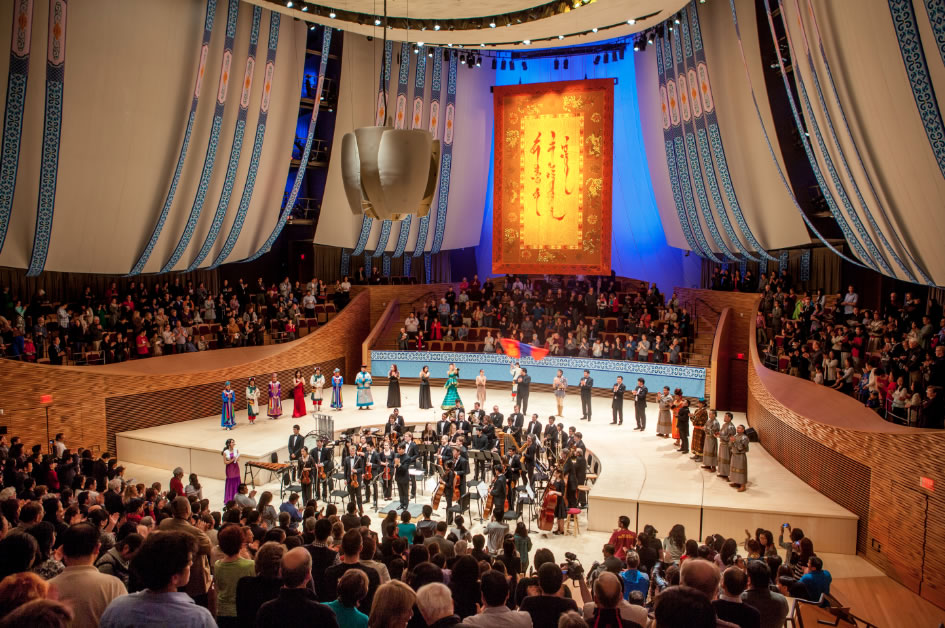
Stanford’s Pan-Asian Music Festival marks a 10-year milestone, and keeps going
Founder and artistic director Jindong Cai brings people and traditions from East and West together through music.
The Pan-Asian Music Festival has been a musical odyssey for founder and artistic director Jindong Cai, and 10 years in, the journey continues. He sees endless possibilities for future festivals built around Asian countries, regions and artistic forms. With the 2014 festival a few days behind him, Cai is already thinking of 2015 and beyond and he is prepared to venture across the globe to find more artists representing the musical riches of Asia.
“The Consul General of Russia attended this year’s Mongolian concert and suggested the inclusion of Russian Siberia,” said Cai, who will add that to a list of ideas under consideration, including the music of Southeast Asia, Myanmar and Thailand, the sacred music of Buddhism and symphonic music by Asian composers. The Asian soundscape is indeed vast.
Cai’s goal, starting with the inaugural festival in 2005, has been to promote an understanding and appreciation of music in contemporary Asia and provide an opportunity for students to develop the cultural awareness that is essential to a 21st-century education and global leadership. With each festival, Cai tries to answer the question, How does music play a part in today’s life?
Over the years, Cai has expanded the music festival to include programs that support the performances: symposia, demonstrations, family concerts, film screenings, exhibitions, tea ceremonies and workshops. Last year there was a musical instrument “petting zoo” for the younger patrons in the lobby of Bing Concert Hall.
“I feel fortunate to have strong support for the programs not only from the Department of Music but from so many different departments across campus,” said Cai in reference to both financial support and faculty participation in the programs. “The festival embodies the Stanford spirit of interdisciplinary collaboration.”
Superstars and zithers
Festivals past have included non-Western superstars, such as A.R. Rahman, the Indian Bollywood composer known for his contributions to Tamil and Hindi films, and Cui Jian, the godfather of Chinese rock ‘n’ roll.
Abbas Milani, director of Stanford’s Iranian studies program and a festival partner, recalls a superstar highlight from 2011. “The Iranian musician Mohsen Namjoo had been a visiting scholar for our program and at the Humanities Center. He embodied the new spirit of musical revolution in Iran, taking aspects of Iranian classical music, forging a new sound and rhythm by fusing it with a wide variety of other musical traditions, from jazz and hip-hop to folk music and punk rock.
“One of the proudest moments of my 12 years at Stanford was when I was sitting in the audience and the Stanford Orchestra, conducted by Jindong, performed a sublime piece of Persian music, with Namjoo as the soloist.”
The breadth of the festivals speaks to the diversity of Asian music. In addition to regional presentations (“From the Steppes,” 2011), festivals have also focused on illuminating themes, such as “Visions of Asian Music” (2010), which explored visual subject matter in Asian music.
In the case of “Drum Beats of Asia” (2007), a single instrument type was played by artists from Burma, India, Japan, Korea and Thailand in a giant pan-Asian jam. “Transforming Traditions” (2012) featured three masters of the instruments descended from the ancient Chinese zither – Japan’s koto, Korea’s gayageum and contemporary China’s gu-zheng – all on the same stage.
Gordon Chang, another festival partner and director of the Center for East Asian Studies, believes the Pan-Asian Music Festival has been an extraordinary contribution to Stanford’s intellectual, cultural and artistic environment. “As a self-conscious ‘Pacific’ university, Stanford is fortunate to have enjoyed the festival. I have attended several performances over the years and each has been unique and incredibly educational as well as enjoyable,” said Chang, who is a professor of history.
“It has been a remarkable 10 years during which we have explored many of the rich and diverse musical cultures from Asia,” said Cai. “With the festival as our looking glass, we hope to continue bringing people and traditions from East and West together through music here at Stanford.”
